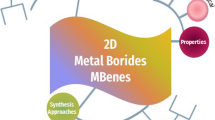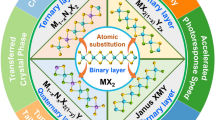Abstract
Layered organic-inorganic hybrid materials based on tungsten oxide as the inorganic framework have been synthesised to include transition metal ions. The resulting materials have been characterised using a number of techniques. X-ray diffraction shows an interlayer expansion with increasing alkyl length. Infrared vibrational spectra of manganese tungstate compounds indicate the organic amine molecules are neutrally charged, and the inorganic framework is unaltered as one varies the organic intercalate. The magnetic behaviour of the materials has also been explored using a SQUID magnetometer. In the manganese tungstate hybrids an antiferromagnetic (AF) transition is observed, which decreases in temperature as the inorganic interlayer spacing is increased. A nickel tungstate hybrid sample, on the other hand, displays a ferromagnetic transition, which we attribute to a canted AF phase below 15 K. In all cases studied, the behaviour can be mapped to an effective moment (Peff) per transition metal ion, which agrees well with theoretical and literature values for other transition metal oxides.
Similar content being viewed by others
References
P. Hagenmuller, “Tungsten Bronzes, Vanadium Bronzes and Related Compounds”, Comprehensive Inorganic Chemistry ed. J.C. Bailar Jr., H.J. Emeleus, R. Nyholm, A.F. Trotman-Dickenson (Pergamon, Oxford 1973) pp. 541–563.
B.W. Brown and E. Banks, J. Am. Chem. Soc. 76 963 (1954).
K.S. Ahn, Y.C. Nah, Y.E. Sung, K.Y. Cho, S.S. Shin and J.K. Park, Appl. Phys. Lett. 81 3930 (2002).
B. Mourey, M. Hareng, B. Dumont, J. Desseine and M. Figlarz, Eurodisplay Proceedings (1984) p. 223.
J.D. Guo, K.P. Reis and M.S. Whittingham, Solid State Ionics 53 305 (1992).
J.T. Szymanski and A.C. Roberts, Can. Mineralogist 22 681 (2004).
B. Ingham, S.V. Chong and J.L. Tallon in Self Assembled Nanostructured Materials, ed. Y. Lu, C.J. Brinker, M. Antonietti and C. Bai (Mater. Res. Soc. Proc. 775, San Francisco, CA, 2003) pp. 165–171.
K.C. Li and C.Y. Wang, Tungsten (Reinhold Publishing, 1947) pp. 253–260.
S. Krustev, K. Ivanov and D. Klissurski, J. Alloys Compounds 182 189 (1992).
C. Belitto, F. Federici, M. Colapietro, G. Portalone and D. Caschera, Inorg. Chem. 41 709 (2004).
L.G. van Uittert,, R.C. Sherwood, H.J. Williams, J.J. Rubin and W.A. Bonner, J. Phys. Chem. Solids 25 1447 (1964).
N.W. Ashcroft and N.D. Mermin, Solid State Physics (Brooks Cole, 1976) pp. 656–658.
Author information
Authors and Affiliations
Rights and permissions
About this article
Cite this article
Ingham, B., Chong, S. & Tallon, J.L. Layered Tungsten Oxide-Based Hybrid Materials Incorporating Transition Metal Ions. MRS Online Proceedings Library 847, 473–478 (2004). https://doi.org/10.1557/PROC-847-EE9.31
Published:
Issue Date:
DOI: https://doi.org/10.1557/PROC-847-EE9.31




